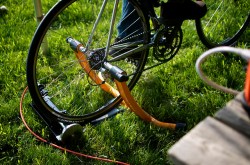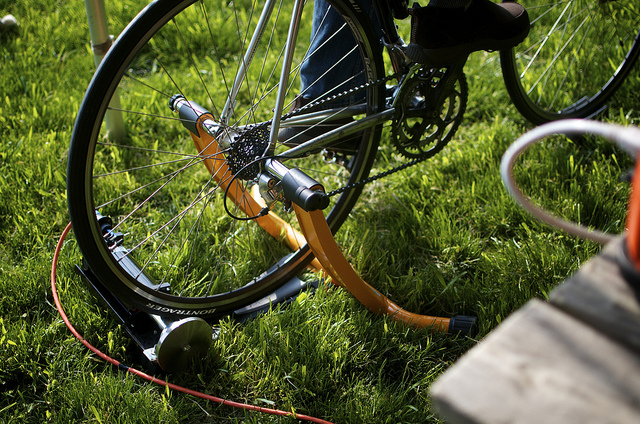Send your question to Umbra!
Q. Dear Umbra,
I really like Paolo Bacigalupi’s fiction; I read it, teach it, and write about it. His short story “The Calorie Man” and his novel The Windup Girl have me wanting to employ my exercise calories toward something more than moving my bike around the neighborhood. Are there any inventions available that would allow me to pedal my calories into electricity for my toaster?
Eric O.
Naples, Fla.

Hugger IndustriesA bicycle-powered generator.
A. Dearest Eric,
I must confess to not being overly familiar with the work of Bacigalupi, although he has appeared in Grist and I am acquainted with people who know and admire him. From what I gather, he writes of a world dominated by agribusiness, greed, and rising seas attributed to climate change … and they call it “science fiction.” Hm.
Your question of course brings to mind another forward-looking fellow, one Ed Begley, Jr. The actor famously powers his toaster with a stationary bike, among his many green habits. Actually, innovative ideas for capturing human energy are all over the headlines, from people-powered gyms to a pedal-powered log-splitter to a concept home powered by exercise. But are such systems within reach of us mere mortals, or even something for which we should aim?
The first answer is yes, they are theoretically within reach — if you have a lot of cash. There are gadgets available that allow you to generate power using your regular bicycle. These are typically in the form of a stand that you pop your bike into; it is connected to a battery that stores the energy for later use. Devices like this have been put to work in the developing world, where electricity can be hard to come by, and at off-grid events including the Occupy protests. There is no denying their sheer ingenuity (but stay tuned for my thoughts on their practicality).
How much biking would it take to fire up your toaster? Well, your typical cyclist puts out about 100 watts, and a toaster requires 800 to 1,000 watts. There’s some loss involved in the energy capture and storage. According to Begley, it takes “15 minutes of hard riding … to toast two slices of bread.”
There are two main reasons why this route might not be practical for you, Eric: First, the cost is prohibitive for most people, typically around $500-$1,000 or more. You could try your hand at building your own, but even the DIY model is estimated to start at $300. Second, it is … kind of a dumb idea. At least for your average homeowner in the developed world. We use an insane amount of power at home, a fact colorfully illustrated by the BBC when it rounded up 80 cyclists to power a family’s home for a day. For a while, teams of 10 or 20 cyclists could keep things going, but at one point all 80 weren’t enough. A smaller-scale experiment at Middlebury College has been similarly eye-opening. Turns out the bike-generator idea, though cool, is pretty darned inefficient; here are two pieces that explain why, one short and passionate and the other long and nerdy.
What you should really do, Eric – what we should all do — is this:
1. Make sure our homes are as energy-efficient as possible.
2. Try to use less energy at home.
3. Visit the EPA’s Power Profiler or talk to your utility to find out what exactly is powering your toaster and everything else: hydro, coal, nuclear, gas, oil, renewable, or spinach juice (hi, just seeing if you’re paying attention).
4. If your utility offers the option of choosing green power, do it. If you can afford solar panels or can find some rebate program that makes installing them more affordable, do it. It will pay off, I promise. (See why U.S. utilities are afraid of solar panels.)
If you are intent on doing something useful with those burning thighs, you could look into getting a cute little gadget-charger for your bike, which is a good deal cheaper — and perhaps more suited to your lifestyle — than the generators discussed above. You could also get creative and build yourself a blender bike [PDF] or an ice cream maker bike, both of which would put your muscle power directly into your culinary efforts instead of converting your energy into electricity first. Finally, you might be interested in a book called The Human-Powered Home. I haven’t read it all, but it talks about things we can do to reduce our reliance on fossil fuels, and might contain some new and exciting ideas for you.
Kink-springly,
Umbra



